Indian passport
An Indian passport is issued by the Indian Ministry of External Affairs to Indian citizens for the purpose of international travel. It enables the bearer to travel internationally and serves as proof of Indian citizenship as per the Passports Act (1967). The Passport Seva (Passport Service) unit of the Consular, Passport & Visa (CPV) Division of the Ministry of External Affairs functions as the central passport organisation, and is responsible for issuing Indian passports on demand to all eligible Indian citizens. Indian passports are issued at 93 passport offices located across India and at 162 Indian diplomatic missions abroad.[2]
| Indian Passport | |
|---|---|
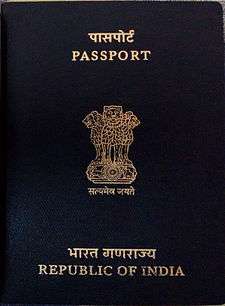 The front cover of an ordinary Indian passport. | |
| Type | Passport |
| Issued by | |
| First issued | 1920 (first version) 1986 (current version) |
| Purpose | Identification |
| Valid in | All countries |
| Eligibility | Indian citizenship |
| Expiration | 10 years (Adult) 5 or 10 years (age 15 to 18) 5 years (Minor) |
| Cost | Adult (36 pages): ₹1,500[1] Adult (60 pages): ₹2,000[1] Minor (36 pages): ₹1,000[1] Note: If the application for a new passport is made under the Tatkaal (expedited processing), the additional Tatkaal fee of ₹2,000 is to be paid in addition to the regular application fee.[1] |
In 2015, India issued about 12 million passports, a number exceeded only by China and the United States.[3] Approximately 65 million Indians held valid passports as of the end of 2015.[3]
History

British Raj
British Indian passports were issued to British subjects of the British Indian Empire, as well as to British subjects from other parts of the British Empire, and subjects of the British protected states in India (i.e. British protected persons of the 'princely states').[4] These passports were introduced in British India after the First World War.[5] The Indian Passport Act of 1920 required the use of passports, established controls on the foreign travel of Indians, and foreigners travelling to and within India.[6] The passport was based on the format agreed upon by the 1920 League of Nations International Conference on Passports.[7] However, the British Indian passport had very limited usage, being valid for travel only within the British Empire, Italy, Switzerland, Austria, Czechoslovakia, Germany, France, Spain, Norway, Sweden and Holland.[8]
Dominion of India
The use of the passport was discontinued after the establishment of the dominions of India and Pakistan in 1947, and its bearers were entitled to opt for Indian, Pakistani or British nationality. Passport laws were made strict in both the countries in 1952. Despite Pakistan's continued aggression and infiltration, Indian government allowed visa free arrival from Pakistan until second Kashmir War. [9]

Types of passport
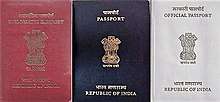
- Ordinary Passport (Dark Blue cover) is issued to ordinary citizens for ordinary travel, such as for vacation, study and business trips (36 or 60 pages). It is a "Type P" passport, where P stands for Personal.
- Official Passport (White cover) is issued to individuals representing the Indian government on official business. It is a "Type S" passport, S stands for Service.
- Diplomatic Passport (Maroon cover) is issued to Indian diplomats, Members of Parliament, members of the Union Council of Ministers, certain high-ranking government officials and diplomatic couriers. Upon request, it may also be issued to high-ranking state-level officials travelling on official business. It is a "Type D" passport, with D standing for Diplomatic.
In addition, selected passport offices in India as well as overseas missions were authorised to issue regular India-Bangladesh Passport to Indian nationals resident in West Bengal and the North-Eastern States and India-Sri Lanka Passport to Indian nationals resident in Tamil Nadu and Puducherry. These two passports respectively permitted travel to Bangladesh and Sri Lanka only and were not valid for travel to other foreign countries. India stopped issuing the Indo-Bangladesh Passport in 2013.[10]
Physical appearance
Contemporary ordinary Indian passports have deep bluish cover with golden coloured printing. The Emblem of India is emblazoned in the centre of the front cover. The words "भारत गणराज्य" in Devanagari and "Republic of India" are inscribed below the Emblem whereas "पासपोर्ट" in Devanagari and "Passport" in English are inscribed above the emblem. The standard passport contains 36 pages, but frequent travellers can opt for a passport containing 60 pages. Some early passports were handwritten, including some issued between 1997 and 2000 with 20-year validity dates. These passports have been ruled invalid by the Indian government and holders must replace them with machine-readable versions good for 10 years due to ICAO regulations.[13]
Identity Information Page
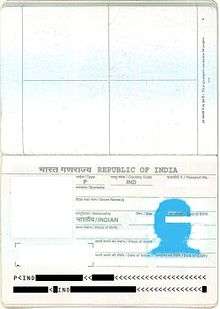
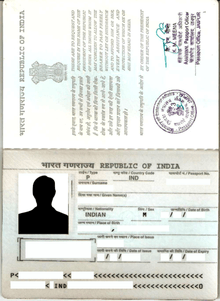
- The Bio data page contains the following information:
- Type: "P"- Stands for "Personal", "D"- Stands for "Diplomatic", "S"- Stands for "Service"
- Country code: IND
- Passport number
- Surname
- Given name(s)
- Sex
- Date of birth
- Place of birth
- Place of issue
- Date of issue
- Date of expiry
- Photo of passport holder
- Ghost picture of the passport holder (only passports issued since 2013)
- Signature of the passport holder
- The information page ends with the Machine Readable Passport Zone (MRZ).
- The Demographics page at the end of the passport book contains the following information:
- Name of father or legal guardian
- Name of mother
- Name of spouse
- Address
- Old passport number
- File number
Passport note
All passports contain a note in Hindi and English, nominally from the President of India, addressing the authorities of all countries and territories:
इसके द्वारा, भारत गणराज्य के राष्ट्रपति के नाम पर, उन सब से जिनका इस बात से सरोकार हो, यह प्रार्थना एवं अपेक्षा की जाती है कि वे वाहक को बिना रोक-टोक, स्वतंत्रतापूर्वक आने-जाने दें, और उसे हर प्रकार की ऐसी सहायता और सुरक्षा प्रदान करें जिसकी उसे आवश्यकता हो ।
- भारत गणराज्य के राष्ट्रपति के आदेश से
These are to request and require in the Name of the President of the Republic of India all those whom it may concern to allow the bearer to pass freely without let or hindrance, and to afford him or her, every assistance and protection of which he or she may stand in need.
- By order of the President of the Republic of India
The note bearing page is typically stamped and signed by the issuing authority in the name of the President of the Republic of India.
Languages
The text of Indian Passport is printed in both Hindi and English, two official languages of India.
Emigration check
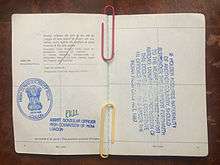
Holders of Emigration Check Required (ECR) type passports need a clearance called an Emigration Check from the Government of India's Protector of Emigrants when going to selected countries on a work visa. This is to prevent the exploitation of Indian workers (especially the unskilled and less-educated) when going abroad, particularly to Middle Eastern countries. ECR type passport holders travelling on a tourist visa do not need a clearance; this is known as an Emigration Check Suspension.
Emigration Check Not Required (ECNR) status passports are granted to:
- Indian nationals born abroad;
- Indian nationals holding at least a matriculation certificate;
- All holders of diplomatic or official passports.
- All gazetted government servants;
- All income-tax payers (including agricultural income-tax payers) in their individual capacity;
- All graduate and professional degree holders (such as doctors, engineers, chartered accountants, scientists, lawyers, etc.);
- Spouses and dependent children of category of certain holders of ECNR passports;
- Seamen in possession of a CDC;
- Sea Cadets and Deck Cadets who have:
- Passed their final examination on a three-year BSc Nautical Sciences Course at T.S. Chanakya, Mumbai; and
- Undergone three months' pre-sea training at any of the government-approved training institutes such as T.S. Chanakya, T.S. Rehman, T.S. Jawahar, MTI (SCI), or NIPM, Chennai, after production of identity cards issued by the Shipping Master at Mumbai, Kolkata, or Chennai;
- Persons holding a Permanent Immigration Visa, such as visas issued by the UK, USA, or Australia;
- Persons possessing a two years' diploma from any institute recognized by the National Council for Vocational Training (NCVT) or the State Council of Vocational Training (SCVT), or persons holding a three years' diploma or equivalent degree from an institution such as a polytechnic recognized by the central or a state government;
- Nurses possessing qualifications recognised under the Indian Nursing Council Act, 1947;
- All persons above the age of 50 years;
- All persons who have been staying abroad for more than three years (whether in one continuous period or in aggregate), as well as their spouses;
- All children up to the age of 18 years.
In accordance with a ruling by the Ministry of External Affairs, passports issued from 2007 onwards do not have the ECNR stamp affixed; instead, a blank page 2 of the passport is deemed to have been ECNR endorsed. As a result, only ECR stamps are now affixed to Indian passports. For passports issued before January 2007, no notation in the passport means ECR. For passports issued in or after January 2007, no notation in the passport means ECNR. If Emigration Check is Required, there will be an endorsement in the passport regarding ECR.
Features
Since 25 November 2015, Indian passports that are handwritten or with an original date of expiry extending to 20 years have not been valid under ICAO travel regulations.[14] With more recent Indian passports the personal particulars of the passport holder, that were hitherto printed on the inner cover page, are printed on the second page of the document. Another added security feature in the newer non-handwritten passports is a ghost picture of the holder found on the right side of the second page. Apart from stymieing criminals from printing fake passports, recent changes also help prevent smudging of the document because of inkjet printers.[15][16]
Fees
The price of a standard passport in India:[17]
- ₹1500 – Fresh issuance or reissue of passport (36 pages, standard size) with 10-year validity.
- ₹2000 – Fresh issuance or reissue of passport (60 pages, 'jumbo' size) with 10-year validity.
- ₹3500 – First time applicant or renewal with expedited ('tatkaal') service (36 pages) with 10-year validity.
- ₹4000 – First time applicant or renewal with expedited ('tatkaal') service (60 pages) with 10-year validity.
- ₹1000 – Fresh passport issuance for minors (below 18 years of Age) with 5-year validity or till the minor attains the age of 18, whichever is earlier.
- ₹3000 – Duplicate passport (36 pages) in lieu of lost, damaged or stolen passport.
- ₹3500 – Duplicate passport (60 pages) in lieu of lost, damaged or stolen passport.
Indian passports can also be issued outside India, for which fees varies by country.
Issuance
Passport Seva Kendra
In September 2007, the Indian Union Council of Ministers approved a new passport issuance system under the Passport Seva Project. As per the project, front-end activities of passport issuance, dispatch of passports, online linking with police, and Central Printing Unit for centralised printing of passports will be put in place. The new system is trying to be 'timely, transparent, more accessible and reliable manner' for passport issuance. The applicant has to apply for fresh/reissue of passport through the Passport Seva system at one of the 77 Passport offices known as "Passport Seva Kendra"s operating throughout the country.
Biometric passport
India initiated the first phase of biometric e-passport for Diplomatic passport holders in India and abroad. The new passports have been designed locally by the Central Passport Organisation, the India Security Press and IIT Kanpur. It contains a security chip with all personal data and digital images. In the first phase new passports will have a 64KB chip carrying a photograph of the passport holder and in subsequent phases it will have a fingerprint. The new passport has already been tested with passport readers in the United States and has 4-second response time, while the US Passport has 10-second response time. It need not be carried in a metal jacket for security reasons. It will first need to be skimmed through a reader, after which it would generate an access code which then unlocks the chip for reader access.[18]
In India, the e-passport is under its first phase of deployment and is restricted to Diplomatic passport holders. On 25 June 2008 the Indian Passport Authority issued the e-passport to the then President of India Pratibha Patil.[19] As of 2016, the Government has plans to issue e-passports to all of its citizens. Also the Government has authorized Indian Security Press to float a global three-stage tender for procurement of ICAO-compliant electronic contactless inlays along with its operating system, which is required for the manufacture of Biometric Passports.[20] The necessary procurement have been initiated by India Security Press, Nasik by calling for Global tender for the supply of electronic contactless inlays.[21] The actual transition to the new age passport is expected to commence on the successful completion of the tendering and procurement process. [22] The Biometric E-Passport work is currently in progress/pipeline and is yet to be available for Ordinary Passport holders. [23] The availability and implementation of E-Passport will now be further delayed for an year or 2 years due to COVID-19 pandemic. [24]
Passport power and visa requirements
Visa requirements for Indian citizens are administrative entry restrictions by the authorities of other states placed on citizens of India.
Passport Power Ranking and visa-free travel
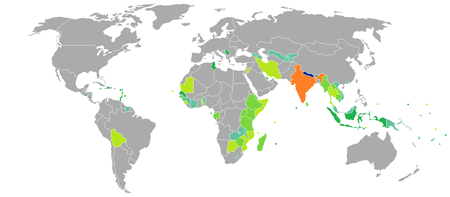
As of June 2020, Henley Passport Index ranks Indian passport at 85th place with visa-free or visa on arrival access to 58 nations and territories to Indian citizens. [25] As of September 2019, The Passport Index ranks Indian passport 70th place on global ranking with 70 mobility ranking (based on visa-free or visa on arrival access to nations or territories).[26] Furthermore, Indian citizens may live and work freely in Nepal under the terms of the 1950 Indo-Nepal Treaty of Peace and Friendship.
Foreign travel statistics
According to the statistics these are the numbers of Indian visitors to various countries in 2017 (unless otherwise noted)
- Data for 2016
- Data for 2017
- Counting only guests in tourist accommodation establishments.
- Data for arrivals by air only.
- Data for 2012
- Data for 2014
- Data for arrivals by air only.
- Total number includes tourists, business travelers, students, exchange visitors, temporary workers and families, diplomats and other representatives and all other classes of nonimmigrant admissions (I-94).
- Data for 2015
Gallery of historic images
 British Indian passport issued during the colonial days
British Indian passport issued during the colonial days Indian passport, valid only for India-Pakistan travel, issued to migrants to enable them to visit family, friends and ancestral homes located on the other side of the Radcliffe line
Indian passport, valid only for India-Pakistan travel, issued to migrants to enable them to visit family, friends and ancestral homes located on the other side of the Radcliffe line Passport issued by the Dominion of India (1947–1950)
Passport issued by the Dominion of India (1947–1950) Cover of a passport (1986)
Cover of a passport (1986)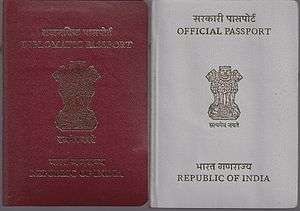 Indian Diplomatic passport and Indian Official passport
Indian Diplomatic passport and Indian Official passport
See also
- Visa requirements for Indian citizens
- Visa policy of India
- Indian nationality law
- Overseas Citizenship of India
- The Passports Act
References
- "Fee Structure : Document Advisor – Passport Seva". passportindia.gov.in. Archived from the original on 23 March 2018. Retrieved 26 March 2018.
- "MEA CPV Division". CPV. Archived from the original on 9 April 2008. Retrieved 18 February 2008.
- "India ranks third in issuing passports – Times of India". Times of India. 1 January 2016. Archived from the original on 2 January 2016. Retrieved 29 January 2016.
- "Dominions 1931–1947". Historical Atlas of the British Empire. Archived from the original on 22 December 2015. Retrieved 16 December 2015.
- MumbaiSpace Indian Passport History Archived 6 October 2010 at the Wayback Machine
- "Passport (Entry into India) Act, 1920 (No. 34 of 1920)". Archived from the original on 7 October 2012. Retrieved 20 April 2019.
- "History of Passports". Archived from the original on 15 April 2009. Retrieved 20 April 2019.
- Vazira Fazila-Yacoobali Zamindar (2007). The Long Partition and the Making of Modern South Asia. Columbia University Press. p. 162. ISBN 0-231-13846-6.
- "Archived copy". Archived from the original on 20 April 2019. Retrieved 20 April 2019.CS1 maint: archived copy as title (link)
- "41-year-old India-Bangladesh passport regime ends". Times of India. 2 December 2013. Archived from the original on 6 October 2018. Retrieved 6 October 2018.
- Tatkaal passports. "Tatkaal passports". www.passportindia.gov.in. CPV, Government of India. Archived from the original on 22 April 2017. Retrieved 22 April 2017.
- "Passport Seva Miscellaneous Queries". passportindia.gov.in. CPV, Government of India. Archived from the original on 7 May 2017. Retrieved 22 April 2017.
- "Archived copy". Archived from the original on 30 December 2018. Retrieved 30 December 2018.CS1 maint: archived copy as title (link)
- the Times of India website article Archived 27 November 2016 at the Wayback Machine accessed 29 January 2016
- Oppili, P. (12 April 2013). "New passports with added security features dispatched". Archived from the original on 5 March 2018. Retrieved 26 March 2018 – via www.thehindu.com.
- "A ghost in your passport to make it tamper-proof – Times of India". Archived from the original on 30 July 2013. Retrieved 14 April 2013.
- "Indian Passport Fees" (PDF). Government of India. Archived (PDF) from the original on 18 January 2013. Retrieved 19 December 2012.
- "NDTV.com: After US tests, India to get first e-passport". ndtv.com. Archived from the original on 14 February 2009. Retrieved 26 March 2018.
- "India to introduce biometric passports next year". secureidnews.com. 5 July 2012. Archived from the original on 18 September 2012. Retrieved 7 October 2012.
- "India to introduce biometric passports to all of its Citizens". Ministry of External Affairs, Parliament Q&A – 1724. 27 July 2016. Archived from the original on 23 August 2018. Retrieved 7 May 2020.
- "Indian Security Press Global Tender for Supply Electronic contactless inlays" (PDF). Indian Security Press- Nashik, Tender No-54/2016-17. 27 July 2016. Archived (PDF) from the original on 22 October 2016. Retrieved 3 August 2016.
- "India looks to Biometric Passports". Security Documentworld.com. 28 July 2016. Archived from the original on 29 April 2019. Retrieved 3 August 2016.
- "E-Passport coming soon! Indians to get chip-enabled passports with advanced security features; details". The Financial Express. 19 July 2019. Retrieved 23 June 2020.
- "E-passport Market COVID 19 Impact New Study Report". MarketWatch. Retrieved 23 June 2020.
- "Henley Passport Index 2020". Henley Passport Index. Henley & Partners. Retrieved 23 June 2020.
- "The Passport Index 2019". The Passport Index. Archived from the original on 2 June 2019. Retrieved 4 September 2019.
- "Statistical Yearbook – Department of Commerce". Archived from the original on 11 February 2017. Retrieved 9 February 2017.
- "Anuário de Estatística do Turismo". Archived from the original on 13 June 2017. Retrieved 15 October 2017.
- "Tourism Statistics – IAATO". iaato.org. Archived from the original on 14 April 2018. Retrieved 26 March 2018.
- "Tourism Statistics for Antigua and Barbuda". antiguahotels.org. Archived from the original on 29 January 2018. Retrieved 26 March 2018.
- "Archived copy" (PDF). Archived (PDF) from the original on 6 March 2018. Retrieved 6 March 2018.CS1 maint: archived copy as title (link)
- "Archived copy" (PDF). Archived from the original (PDF) on 14 February 2017. Retrieved 30 May 2017.CS1 maint: archived copy as title (link)
- "Number of foreign citizens arrived to Azerbaijan by countries". Archived from the original on 25 June 2019. Retrieved 15 October 2017.
- "Archived copy" (PDF). Archived (PDF) from the original on 3 February 2018. Retrieved 3 February 2018.CS1 maint: archived copy as title (link)
- "Tourisme selon pays de provenance 2016". Archived from the original on 20 August 2017. Retrieved 20 August 2017.
- Namgay, Phunstho. "Annual Reports – Tourism Council of Bhutan". www.tourism.gov.bt. Archived from the original on 12 June 2018. Retrieved 12 June 2018.
- "INE – Instituto Nacional de Estadística – Turismo". Archived from the original on 31 October 2019. Retrieved 15 October 2017.
- "TOURISM STATISTICS Cumulative data, January – December 2017" (PDF). Archived (PDF) from the original on 29 May 2019. Retrieved 20 May 2018.
- "Statistics Botswana". Statistics Botswana. Archived from the original on 21 March 2019. Retrieved 26 March 2018.
- "Archived copy". Archived from the original on 9 December 2018. Retrieved 20 October 2018.CS1 maint: archived copy as title (link)
- "Tourism Statistics Report". www.tourismcambodia.org. Archived from the original on 18 March 2018. Retrieved 26 March 2018.
- "Service bulletin International Travel: Advance Information" (PDF). statcan.gc.ca. Archived (PDF) from the original on 22 February 2017. Retrieved 21 February 2017.
- CIDOT. "Welcome to the Cayman Islands Department of Tourism (CIDOT) Destination Statistics Website". www.caymanislands.ky. Archived from the original on 22 July 2017. Retrieved 26 March 2018.
- Mehta, Shriji (18 October 2018). "Documents Required for Passport in India". Archived from the original on 24 October 2018. Retrieved 24 October 2018.
- "China Inbound Tourism Statistics in 2015". www.travelchinaguide.com. Archived from the original on 29 June 2017. Retrieved 26 March 2018.
- "Tourists in China by country of origin 2016 – Statistic". Statista. Archived from the original on 4 July 2018. Retrieved 18 October 2018.
- The data obtained on request. Ministerio de Comercio, Industria y Turismo de Colombia Archived 6 June 2017 at the Wayback Machine
- "Archived copy" (PDF). Archived (PDF) from the original on 22 May 2017. Retrieved 6 January 2017.CS1 maint: archived copy as title (link)
- "Informes Estadísticos – Instituto Costarricense de Turismo – ICT". www.ict.go.cr. Archived from the original on 24 March 2018. Retrieved 26 March 2018.
- "TOURIST ARRIVALS AND NIGHTS IN 2017". Archived from the original on 21 May 2018. Retrieved 20 May 2018.
- "2015 Visitors Statistics Report" (PDF). tourism.gov.dm. Archived (PDF) from the original on 5 October 2018. Retrieved 26 March 2018.
- "BCRD – Estadísticas Económicas". www.bancentral.gov.do. Archived from the original on 3 February 2017. Retrieved 26 March 2018.
- "Swaziland Tourism – Swaziland Safari – Swaziland Attractions – Useful Links – Research". www.thekingdomofswaziland.com. Archived from the original on 8 February 2018. Retrieved 26 March 2018.
- "Archived copy". Archived from the original on 6 January 2017. Retrieved 5 January 2017.CS1 maint: archived copy as title (link)
- "Données détaillées". www.ispf.pf. Archived from the original on 14 November 2017. Retrieved 26 March 2018.
- "International arrivals 2017". Archived from the original on 7 January 2018. Retrieved 7 January 2018.
- Tourismus in Zahlen 2016 Archived 4 March 2017 at the Wayback Machine, Statistisches Bundesamt
- "Visitor Arrival Statistics – Research – Research and Reports". www.guamvisitorsbureau.com. Archived from the original on 7 July 2018. Retrieved 26 March 2018.
- "Archived copy" (PDF). Archived from the original (PDF) on 31 January 2018. Retrieved 30 January 2018.CS1 maint: archived copy as title (link)
- "TOURISM IN HUNGARY 2016". Archived from the original on 8 October 2017. Retrieved 4 March 2017.
- "Archived copy". Archived from the original on 14 October 2017. Retrieved 14 October 2017.CS1 maint: archived copy as title (link)
- TOURIST ARRIVALS TO ISRAEL (EXC. DAY VISITORS & CRUISE PASSENGERS) BY NATIONALITY Archived 22 April 2018 at the Wayback Machine, Ministry of Tourism
- "IAGGIATORI STRANIERI NUMERO DI VIAGGIATORI". Archived from the original on 14 October 2017. Retrieved 13 June 2017.
- "Monthly Statistical Report December 2017 Vol xxvii No 12". Archived from the original on 11 February 2017. Retrieved 9 February 2017.
- "2015 Foreign Visitors & Japanese Departures" (PDF). jnto.go.jp. Japan National Tourism Organization. Archived (PDF) from the original on 19 February 2018. Retrieved 26 March 2018.
- "Tourist Overnight and Same Day Visitors By Nationality during". Archived from the original on 13 April 2018. Retrieved 15 October 2017.
- "Статистические сборники". stat.gov.kz. Archived from the original on 21 December 2016. Retrieved 9 December 2016.
- "Туризм в Кыргызстане – Архив публикаций – Статистика Кыргызстана". www.stat.kg. Archived from the original on 14 October 2018. Retrieved 14 October 2018.
- "Statistical Reports on Tourism in Laos". Archived from the original on 4 December 2018. Retrieved 28 November 2018.
- "TUG02. Visitors staying in hotels and other accommodation establishments by country of residence-PX-Web". csb.gov.lv. Archived from the original on 14 October 2017. Retrieved 26 March 2018.
- "Arrivals according to nationality during year 2016". Archived from the original on 13 November 2018. Retrieved 15 October 2017.
- "DSEC – Statistics Database". www.dsec.gov.mo. Archived from the original on 21 November 2017. Retrieved 26 March 2018.
- "Publications – Statistiques". tourisme.gov.mg. 27 May 2015. Archived from the original on 6 January 2017. Retrieved 26 March 2018.
- "TOURIST ARRIVALS TO MALAYSIA BY COUNTRY OF NATIONALITY DECEMBER 2017" (PDF). tourism.gov.my. Archived from the original (PDF) on 5 March 2018. Retrieved 26 March 2018.
- "December 2017 – Ministry of Tourism". www.tourism.gov.mv. Archived from the original on 25 January 2018. Retrieved 26 March 2018.
- "ANNUAIRE 2014". Archived from the original on 7 January 2017. Retrieved 6 January 2017.
- "Visitantes internacionales por vía aérea por principal nacionalidad". sectur.gob.mx. Archived from the original on 4 April 2018. Retrieved 26 March 2018.
- "Archived copy". Archived from the original on 12 February 2018. Retrieved 11 February 2018.CS1 maint: archived copy as title (link)
- "Table 4. Foreign tourist arrivals and overnight stays by countries, 2014" (PDF). monstat.org. Archived (PDF) from the original on 5 March 2016. Retrieved 26 March 2018.
- "Myanmar Tourism Statistics 2015" (PDF). Central Statistical Organization. Ministry of National Planning and Economic Development. Archived from the original (PDF) on 29 December 2016. Retrieved 5 January 2016.
- Tourism Statistics 2015 p.20,31 Archived 31 January 2017 at the Wayback Machine
- "Toerisme in perspectief 2018". Archived from the original on 29 January 2018. Retrieved 28 January 2018.
- "International travel and migration: December 2017". Statistics New Zealand. Archived from the original on 2 February 2018. Retrieved 2 February 2018.
- "Archived copy". Archived from the original on 20 October 2018. Retrieved 19 October 2018.CS1 maint: archived copy as title (link)
- "Archived copy" (PDF). Archived (PDF) from the original on 27 November 2016. Retrieved 26 November 2016.CS1 maint: archived copy as title (link)
- "Archived copy" (PDF). Archived (PDF) from the original on 4 March 2017. Retrieved 4 March 2017.CS1 maint: archived copy as title (link)
- "datosTurismo". datosturismo.mincetur.gob.pe. Archived from the original on 14 October 2018. Retrieved 15 October 2018.
- "Archived copy" (PDF). Archived from the original (PDF) on 10 February 2018. Retrieved 7 March 2018.CS1 maint: archived copy as title (link)
- "2016 Annual Tourism Performance Report" (PDF). visitqatar.qa. Archived (PDF) from the original on 7 November 2017. Retrieved 26 March 2018.
- "Archived copy". Archived from the original on 6 March 2017. Retrieved 5 March 2017.CS1 maint: archived copy as title (link)
- "Въезд иностранных граждан в РФ". Fedstat.ru. 18 October 2017. Archived from the original on 18 October 2017. Retrieved 18 October 2017.
- "Visitor Arrivals". www.stb.gov.sg. Archived from the original on 22 January 2017. Retrieved 26 March 2018.
- "Archived copy" (PDF). Archived (PDF) from the original on 22 November 2017. Retrieved 22 June 2016.CS1 maint: archived copy as title (link)
- "Korea, Monthly Statistics of Tourism – key facts on tourism – Tourism Statistics". kto.visitkorea.or.kr. Archived from the original on 12 October 2015. Retrieved 26 March 2018.
- "Tabla23984". www.ine.es. Archived from the original on 13 February 2017. Retrieved 26 March 2018.
- "TOURIST ARRIVALS BY COUNTRY OF RESIDENCE 2016" (PDF). sltda.gov.lk. Archived from the original (PDF) on 16 December 2017. Retrieved 26 March 2018.
- "Suriname Tourism Statistics" (PDF). www.surinametourism.sr. Archived from the original (PDF) on 12 June 2018. Retrieved 8 June 2018.
- "Visitor Arrivals by Nationality". taiwan.net.tw. Archived from the original on 24 March 2018. Retrieved 26 March 2018.
- "The 2016 International Visitors' Exit Survey Report. International Tourist Arrivals. pp. 73–77" (PDF). nbs.go.tz/. NBS Tanzania. Archived (PDF) from the original on 13 November 2018. Retrieved 18 December 2017.
- "สถิติด้านการท่องเที่ยว ปี 2560 (Tourism Statistics 2017)". Ministry of Tourism & Sports. Archived from the original on 18 August 2017. Retrieved 16 January 2018.
- "2018 Statistics".
- "Archived copy" (PDF). Archived (PDF) from the original on 18 October 2016. Retrieved 16 October 2016.CS1 maint: archived copy as title (link)
- "NUMBER OF ARRIVING-DEPARTING VISITORS, FOREIGNERS AND CITIZENS December 2017". Archived from the original on 1 February 2018. Retrieved 31 January 2018.
- "Foreign citizens who visited Ukraine in 2017 year, by countries". Archived from the original on 14 November 2018. Retrieved 10 February 2018.
- Statistics for the Emirate of Dubai
Dubai Statistics, Visitor by Nationality Archived 3 October 2017 at the Wayback Machine - "Annual estimates on visits and spending in the UK by overseas residents, by purpose and region of visit". Office of National Statistics. Archived from the original on 21 July 2018. Retrieved 20 July 2018.
- "Table 28. Nonimmigrant Admissions (I-94 Only) By Selected Category Of Admission And Region And Country Of Citizenship: Fiscal Year 2016". dhs.gov. 16 May 2017. Archived from the original on 7 November 2018. Retrieved 26 March 2018.
- "Распределение въехавших в Республику Узбекистан иностранных граждан по странам в 2015 году". data.gov.uz. Archived from the original on 30 January 2019. Retrieved 12 March 2018.
- "Tourism Statistical Digests". Archived from the original on 1 July 2016. Retrieved 22 June 2016.
- "Tourism Trends and Statistics 2015 Annual Report – Zimbabwe A World Of Wonders". www.zimbabwetourism.net. Archived from the original on 21 December 2016. Retrieved 26 March 2018.